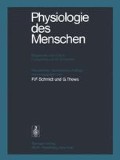Zusammenfassung
Nur mit Hilfe seiner Skeletmuskeln kann der Mensch auf seine Umwelt einwirken und sich mit ihr auseinandersetzen. Dies gilt für die gröbste Handarbeit wie für die Übermittlung der subtilsten Gedanken und Gefühle, zum Beispiel durch Sprechen oder Schreiben, durch Mimik oder Gestik. Alle diese Bewegungen können nur gut und richtig ausgeführt werden, wenn durch eine angemessene Haltung des Körpers und eine entsprechende Stellung der Gliedmaßen die für diese Tätigkeiten notwendigen Ausgangspositionen eingenommen werden.
Access this chapter
Tax calculation will be finalised at checkout
Purchases are for personal use only
Preview
Unable to display preview. Download preview PDF.
Literatur
Barker, D., Emonet-Dénand, F., Laporte, Y., Proske, U., Stacey, M.J.: Morphological identification and intrafusal distribution of the endings of static fusimotor axons in the cat. J. Physiol. (Lond.) 230, 405 (1973).
Boyd, J.A., Davey, M.R.: Composition of Peripheral Nerves. Edinburgh, London: Livingstone 1968.
Brodal, A.: Neurological Anatomy in Relation to Clinical Medicine, 2. Aufl. New York, London, Toronto: Oxford University Press 1969.
Crowe, A., Matthews, P.B.C.: The effects of stimulation of static and dynamic fusimotor fibres on the response to stretching of the primary endings of muscle spindles. J. Physiol. (Lond.) 174, 109 (1964).
Deecke, L., Scheid, P., Kornhuber, H.: Distribution of readiness potential, pre-motion positivity, and motor potential of the human cerebral cortex preceding voluntary finger movements. Exp. Brain Res. 7, 158 (1969).
Dow, R.S., Moruzzi, G.: The physiology and pathology of the cerebellum. Minneapolis: The University of Minnesota Press 1958.
Eccles, J.C.: The Physiology of Nerve Cells. Baltimore: Johns Hopkins Press 1957.
Eccles, J.C.: The inhibitory pathways of the central nervous system. The Sherrington Lectures IX. Springfield/Ill.: Ch.C. Thomas 1969.
Eccles, J.C., Ito, M., Szentágothai, J.: The cerebellum as a neuronal machine. Berlin-Heidelberg-New York: Springer 1967.
Eccles, R.M., Lundberg, A.: Synaptic actions in motoneurones by afferents which may evoke the flexion reflex. Arch. ital. Biol. 97, 199 (1959).
Granit, R.: The Basis of Motor Control. London, New York: Academic Press 1970.
Holmqvist, B., Lundberg, A.: Differential supraspinal control of synaptic actions evoked by volleys in the flexion reflex afferents in alpha motoneurones. Acta physiol. scand. 54, Suppl. 186, 1 (1961).
Jansen, J., Brodal, A.: Handbuch der Mikroskopischen Anatomie des Menschen, IV. Bd.: Nervensystem, 8. Teil: Das Kleinhirn. BerlinGöttingen-Heidelberg: Springer 1958.
Kemp, J.M., Powell, T.P.S.: The connexions of the striatum and globus pallidus: synthesis and speculation. Phil. Trans. B 262, 441 (1971).
Kuhn, R.A.: Functional capacity of the isolated human spinal cord. Brain 73, 1 (1950).
Larsell, O., Jansen, J.: The comparative anatomy and histology of the cerebellum. The human cerebellum, cerebellar connections, and cerebellar cortex. Minneapolis: University of Minnesota Press 1972.
Magnus, R.: Körperstellung. Berlin: Springer 1924.
Matthews, P.B.C.: Mammalian Muscle Receptors and their Central Actions. London: Arnold 1972.
Mountcastle, V.B.: Medical Physiology, Band I, 13. Aufl. Saint Louis: Mosby 1974.
Oscarsson, O.: Functional Organization of Spinocerebellar Paths. In: Handb. of Sensory Physiology, Vol. II, Somatosensory System (Hrsg. A. Iggo), p. 340. Berlin-Heidelberg-New York: Springer 1973.
Palay, S. L., Chan-Palay, V.: Cerebellar Cortex, Cytology and Organization. Berlin-Heidelberg-New York: Springer 1974.
Penfield, W., Rasmussen, T.: The cerebral cortex of man. New York: Macmillan 1950.
Poeck, K.: Neurologie, 3. Aufl. Berlin-Heidelberg-New York: Springer 1974.
Porter, R.: Functions of the mammalian cerebral cortex in movement. In: Progress in Neurobiology (Hrsg. G.A. Kerkut, J.W. Phillis). Oxford: Pergamon Press 1973.
Rademaker, G.G.J.: Das Stehen. Berlin: Springer 1931.
Sato, A., Schmidt, R.F.: Somatosympathetic reflexes: afferent fibers, central pathways, discharge characteristics. Physiol. Rev. 53, 916 (1973).
Schmidt, E.M., Jost, R.G., Davis, K.K.: Reexamination of the force relationship of cortical cell discharge patterns with conditioned wrist movements. Brain Res. 83, 213 (1975).
Schmidt, R.F.: Presynaptic inhibition in the vertebrate central nervous system. Ergebn. Physiol. 63, 20 (1971).
Schmidt, R.F.: Propriozeptoren in Muskeln und Sehnen. In: Physiologie des Menschen, Bd. 11, Somatische Sensibilität, Geruch und Geschmack. (Hrsg. O.H. Gauer, K. Kramer, R. Jung), S. 155. München: Urban & Schwarzenberg 1972.
Schmidt, R.F.: Control of the access of afferent activity to somatosensory pathways. In: Handb. of Sensory Physiology, Vol. II, Somatosensory System (Hrsg. A. Iggo), p. 151. Berlin-Heidelberg-New York: Springer 1973.
Schmitt, O., Worden, F.G. (Hrsg.): The Neurosciences, Third Study Program. Cambridge/Mass., London: MIT Press 1974.
Walter, W.G.: Slow potential waves in the human brain associated with expectancy, attention and decision. Arch. Psychiat. Nervenkr. 206, 309 (1964).
Editor information
Editors and Affiliations
Rights and permissions
Copyright information
© 1977 Springer-Verlag Berlin · Heidelberg
About this chapter
Cite this chapter
Schmidt, R.F. (1977). Motorische Systeme. In: Schmidt, R.F., Thews, G. (eds) Physiologie des Menschen. Springer, Berlin, Heidelberg. https://doi.org/10.1007/978-3-662-00222-3_6
Download citation
DOI: https://doi.org/10.1007/978-3-662-00222-3_6
Publisher Name: Springer, Berlin, Heidelberg
Print ISBN: 978-3-662-00223-0
Online ISBN: 978-3-662-00222-3
eBook Packages: Springer Book Archive

